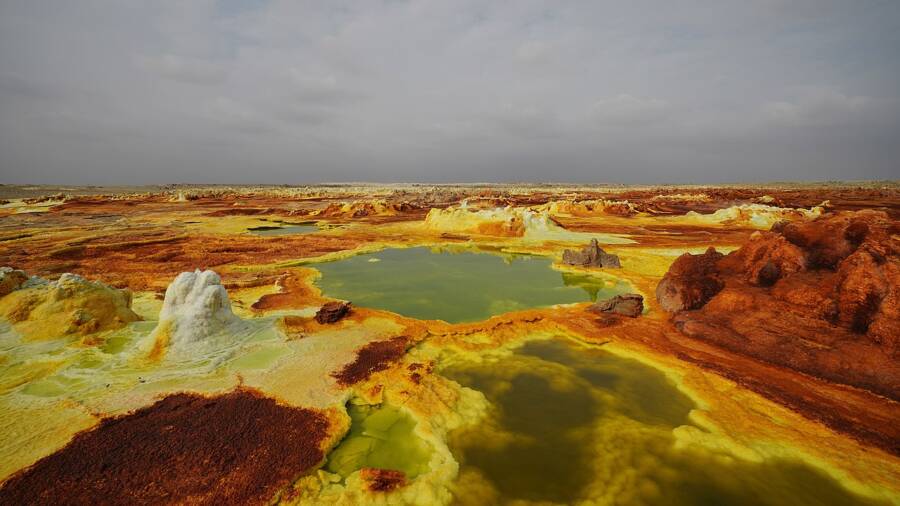Welcome to Dallol, Ethiopia, a place that puts human survival and environmental resilience to the test. The hottest inhabited place on Earth.
How hot is it in Dallol? The average annual temperature in Dallol is 34.6°C (94.3°F) and in the summer, it soars to 40°C (104°F). Its landscape reflects its volcanic origin and geological characteristics. Dallol is stark and bleak with salt flats, acid ponds, sulfur springs, and geysers. It is also known for being dispersed with brightly colored mineral deposits.
Because of the intense geothermal activity in the area, the Earth’s crust it stands on is extremely thin. The heat from below easily escapes with a ravening degree. To add, it is also one of the lowest places on Earth at 125 meters below sea level.
With the Dallol’s sweltering heat, people only visit it but no one lives there permanently. It has a remote location that made it suitable for mining and other commercial operations in the past. In addition, the only way to reach it is by riding a camel. The extreme heat makes it challenging for permanent residence in the area.
The nomadic ethnic group of Danakil Depression, called The Afar People, are known to have adapted to Dallol. They are known for their resilience and ability to survive in such extreme temperatures. However, Dallol only sees seasonal habitation related to economic activities.

Photo Credit: A. Savin/Wikimedia Commons
Even with temporary habitation, living in the hottest place on earth still sparks curiosity. The traditional Afar homes are fashioned from wood and palm fronds to provide shade and airflow. Some homes even have reflective materials to divert the rays of the sun.
With scarce groundwater sources, access to water is a daily challenge. The Afar people use hand-dug wells to extract the water from below. Because of the limited water access, water is a precious commodity that must be used sparingly.
On the other hand, the diet of Dallol inhabitants is simple because it is primarily composed of camel meat and milk with dates and grains as supplements. Dallol is abundant in salt, making it a trade commodity and a dietary component.
It is not without economic activities because of the salt mining is a common venture in the area. Using traditional methods, the miners and workers can extract and transport the salt to markets. In return, their grueling hard work results in a critical source of income for their households.
No matter how hot it is in Dallol, it still boasts its majestic and colorful landscapes. The deposits of sulfur, iron, and minerals give the area an array of yellow, green, and red colors for a visually pleasing view of the place.
Even with its extreme environment, there are tourists and scientists who travel to Dallol, too. A lot of the visitors visit to witness the beauty of its unique geology. But to enjoy its beauty, one must first surpass the overwhelming heat and the taxing terrain.
Despite the small number of people that temporarily live in the area, there are still events in Dallol such as the salt caravans. The people celebrate with camelos, slabs of salt, and the remarkable landscape around them.
Life in Dallol is not just about survival, but it is also about the human’s unyielding will for resilience and ingenuity. The Afar people have truly proven that human endurance can defy relentless heat and unbelievable living conditions. It is a testament of the human’s extraordinary ability to persist and even flourish.



























































